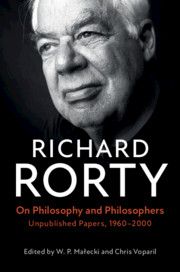Book contents
- On Philosophy and Philosophers
- On Philosophy and Philosophers
- Copyright page
- Contents
- Acknowledgments
- Note on Sources
- Introduction: Rorty as a Critical Philosopher
- I Early Papers
- II Later Papers
- 9 Philosophy as Epistemology: Reply to Hacking and Kim
- 10 Naturalized Epistemology and Norms: Replies to Goldman and Fodor
- 11 The Objectivity of Values
- 12 What Is Dead in Plato
- 13 The Current State of Philosophy in the United States
- 14 Brandom’s Conversationalism: Davidson and Making It Explicit
- 15 Bald Naturalism and McDowell’s Hylomorphism
- 16 Reductionist vs. Neo-Wittgensteinian Semantics
- 17 Remarks on Nishida and Nishitani
- Index of Names
15 - Bald Naturalism and McDowell’s Hylomorphism
from II - Later Papers
Published online by Cambridge University Press: 10 October 2020
- On Philosophy and Philosophers
- On Philosophy and Philosophers
- Copyright page
- Contents
- Acknowledgments
- Note on Sources
- Introduction: Rorty as a Critical Philosopher
- I Early Papers
- II Later Papers
- 9 Philosophy as Epistemology: Reply to Hacking and Kim
- 10 Naturalized Epistemology and Norms: Replies to Goldman and Fodor
- 11 The Objectivity of Values
- 12 What Is Dead in Plato
- 13 The Current State of Philosophy in the United States
- 14 Brandom’s Conversationalism: Davidson and Making It Explicit
- 15 Bald Naturalism and McDowell’s Hylomorphism
- 16 Reductionist vs. Neo-Wittgensteinian Semantics
- 17 Remarks on Nishida and Nishitani
- Index of Names
Summary
In “Bald Naturalism and McDowell’s Hylomorphism,” Rorty distinguishes between two views of the mind’s relation to the world. One view, which he calls “bald naturalism” and attributes to Donald Davidson, sees the mind as a network of intentional states profitable to attribute to certain complexly behaving objects to predict and control their interactions with the environment. The other view, which he dubs “naturalized Platonism” or “hylomorphism” and attributes to John McDowell, sees the mind as a device for getting the world right, where this process consists in the reproduction of the world in the mind. Rorty then uses the distinction to assess the force of McDowell’s criticisms of Davidson’s bald naturalism in Mind and the World. He argues, first, that those criticisms rely on attributing to Davidson a set of views only expressible in terms for which there is no place in his bald naturalism. Second, Rorty holds that those terms belong to McDowell’s hylomorphism and that this view needs to be abandoned, along with the intuitions it expresses. The paper makes this case by pointing to various counterintuitive consequences of McDowell’s view, such as its implication that the world has its own language.
- Type
- Chapter
- Information
- On Philosophy and PhilosophersUnpublished Papers, 1960–2000, pp. 214 - 225Publisher: Cambridge University PressPrint publication year: 2020



